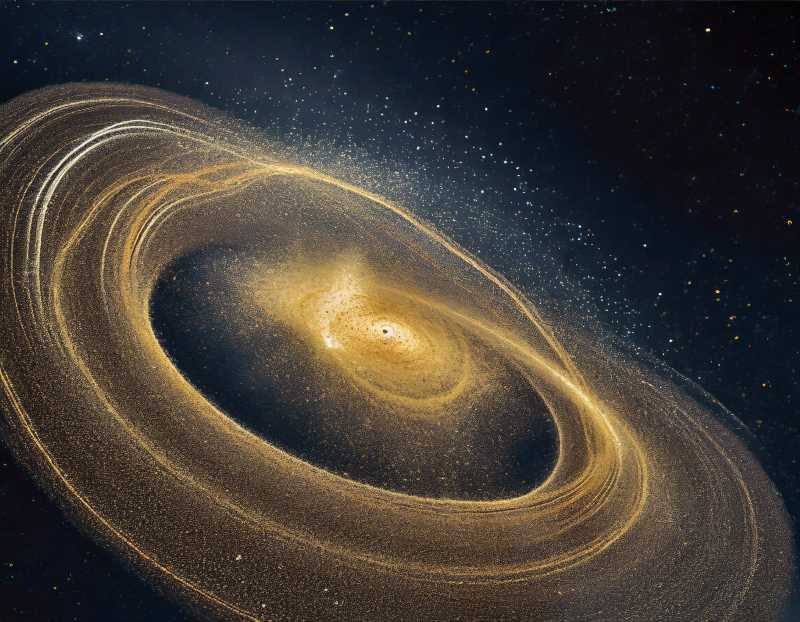Hide-and-Seek in HL Tau's Rings – A Cosmic Mystery Unraveled
Astronomer Carlos Carrasco González unveils secrets of planet formation in HL Tau's dust disk. Unprecedented polarization study reveals elongated dust grains, with denser rings identified as potential hotspots for new planet birth.

In the cosmic theater of celestial bodies, the genesis of planets is a mesmerizing act, choreographed by the interplay of gas and dust surrounding young stars. The latest revelation comes from a groundbreaking study authored by Carlos Carrasco González, a distinguished researcher at UNAM's Institute of Radio Astronomy and Astrophysics (IRyA), Campus Morelia. Published in the prestigious journal Nature, this study unveils previously unseen intricacies of the dust within the protoplanetary disk enveloping the young star HL Tau, ushering us into uncharted territories of understanding the enigmatic process of planet formation.
HL Tau, a youthful star residing 480 light-years away, wears a crown of a protoplanetary disk, a cosmic cradle teeming with gas and dust. Within this celestial nursery, visible gaps hint at the potential birthplaces of protoplanets, adding layers to the tapestry of cosmic evolution that scientists are ardently deciphering. Dust grains within this disk engage, colliding and coalescing, orchestrating the grand movement of planet formation.
To peer into the heart of this cosmic clash, researchers leverage the polarization of light waves emitted by dust grains. The study by Carrasco González provides an unprecedented depth, with ten times more polarization measurements than any previous study and a staggering 100 times more than most disks. The resulting image boasts a resolution of 5 Astronomical Units, a feat akin to peering into the fine details of a cosmic canvas with a clarity hitherto unseen.
Dust grains, akin to celestial artisans, mold themselves into various shapes – from flattened ovals reminiscent of starry eggs to elongated forms resembling grains of rice. When these grains emit or scatter light, polarization occurs, revealing the grains' orientation. Carrasco González's study suggests that the dust within HL Tau's disk favors an elongated form, a revelation that imposes constraints on the size and shape of these cosmic building blocks.
The study exposes that the gaps within the disk exhibit more polarization than the rings, despite the latter containing a higher density of dust. The orientation of polarization within the gaps aligns with the disk's shape, hinting at a unique mechanism governing these regions. The rings, on the other hand, display a more uniform polarization, suggesting a different scattering process. The dust grains' alignment within the gaps remains a cosmic enigma, potentially governed by their aerodynamics rather than the typical magnetic fields observed outside protoplanetary disks.
The study's implications are profound, underscoring the importance of the dense rings as ideal crucibles for new planet formation. While protoplanets are believed to have already formed in the gaps, the rings, being denser, emerge as the focal points for unraveling the early stages of planetary birth. The challenge lies in the rings' density, making them elusive subjects for current instruments. Carrasco González advocates for the Next Generation Very Large Array (ngVLA), a forthcoming radio-wave observatory, to illuminate the secrets hidden within these cosmic rings.
At the forefront of this astronomical revelation stands Carlos Carrasco González, whose expertise in astrophysics, demonstrated through his use of radio interferometers like ALMA and VLA, has been instrumental in deciphering the cosmic symphonies. A key figure in the ngVLA collaboration, his vision extends beyond the scientific realm to nurture young minds through educational initiatives.
As we stand on the precipice of a new era in astrophysics, Carrasco González's study catapults us into the heart of planet formation, where dust grains, like stardust artisans, shape the cosmic ballet of creation. The veil of mystery surrounding HL Tau's protoplanetary disk has been lifted, inviting us to witness the celestial choreography that gives birth to new worlds.




